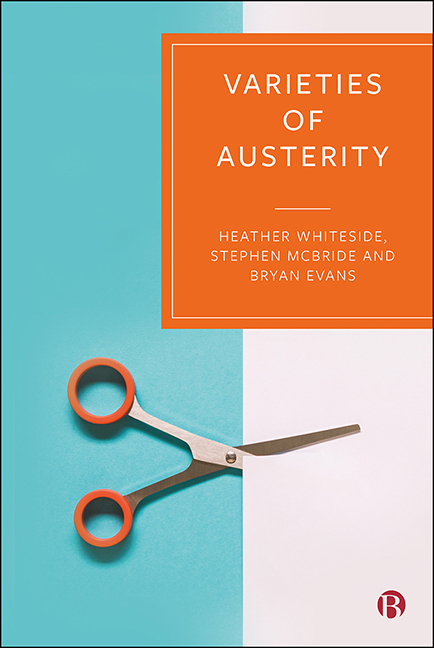Book contents
- Frontmatter
- Contents
- List of Figures and Tables
- About the Authors
- Acknowledgements
- 1 Introduction: Varieties of Austerity
- 2 Spending in an Austere Era
- 3 Selling Restraint
- 4 Transforming the Public Sector
- 5 Class Struggle from Above
- 6 Insecurity and Poverty
- 7 Limits and Possibilities of Resistance
- 8 Conclusion: Beyond Austerity
- Notes
- References
- Index
7 - Limits and Possibilities of Resistance
Published online by Cambridge University Press: 04 January 2022
- Frontmatter
- Contents
- List of Figures and Tables
- About the Authors
- Acknowledgements
- 1 Introduction: Varieties of Austerity
- 2 Spending in an Austere Era
- 3 Selling Restraint
- 4 Transforming the Public Sector
- 5 Class Struggle from Above
- 6 Insecurity and Poverty
- 7 Limits and Possibilities of Resistance
- 8 Conclusion: Beyond Austerity
- Notes
- References
- Index
Summary
Austerity, in one form or another, coloured the politics of the past decade (2008–18). As the previous chapters have demonstrated, austerity comes in varieties: fiscal consolidation by means of balanced budgets and expenditure cuts or restraint, plus multiple modes of public sector restructuring and privatization, and labour restructuring by flexibility and internal devaluation. Having, in previous chapters, tracked the impact of austerity, both as a general programme and in its specific forms, we now turn to the issue of how much and what kind of resistance there has been and its effectiveness in halting or reversing these policies. Reactions to austerity vary enormously from enthusiastic support, to various levels of acceptance and consent (ranging from enthusiasm, to resigned – there is no alternative), to disaffection (Clarke, 2017). Resistance, too, comes in many forms (Dean, 2014; Horvat, 2014). Some actions may be highly individualized, such as refusing to accept responsibility and making the tough choices required by the justificatory rhetoric of austerity (Mitrea, 2017). Others might involve efforts to mitigate the effects through selfsacrificing behaviour (Baines, 2017). Often these responses will barely register on a scale seeking to measure resistance yet they do indicate, where detected, non-acceptance of austerian policies and practices on the part of individuals or spontaneously formed collectivities. Other forms of resistance are more visible and can be compared according to a number of criteria. One might be the scale on which they develop – from highly localized, to regional, national or international. Another is whether resistance is primarily defensive, directed against some specific instance of austerity, such as reductions in a social service, or the eviction of an occupant from housing, or resistance that escalates into a protest against austerity in general. More interesting, from our perspective, is whether they achieve some transformative potential to not only undo some or all austerity measures, but also/instead to construct an alternative that goes beyond it (Pineault, 2014; Graefe and Rioux, 2017).
We see the institutionalization of routes for austerity-related dissent as having emerged through either formal or informal channels via unions, protests and political campaigns or policies.
- Type
- Chapter
- Information
- Varieties of Austerity , pp. 157 - 176Publisher: Bristol University PressPrint publication year: 2021



